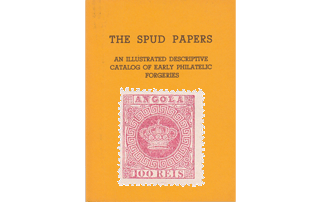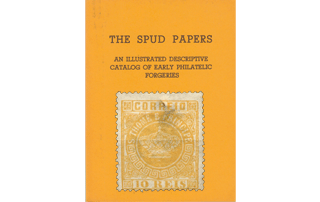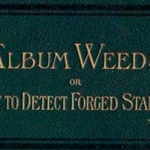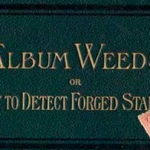Album Weeds – Angola


 Issues of 1870-1885
Issues of 1870-1885
The above are the issues of the Crown type, as catalogued by Gibbons. In the 1881 issue there are two types of the 50 reis, blue—one with an almost straight neck to the 5, and the other with a slanting neck. I cannot say whether the forgers have imitated the changed colors and new values of the later issues, the counterfeits in my possession consisting only of the 5, 10, 25, 50 and 100 reis. Not only the Angola stamps, but also the whole of the stamps of this type, of the various Portuguese colonies, have been extensively forged, and appear to have been pretty well patronised by a too-confiding public.
Genuine
Engraved in épargne; paper and perforation as above, according to the issue. The crown in the centre is very well done, and all the pearls on the arches of the said crown can be easily counted. The numbers of these pearls on the various arches, beginning with the right-hand arch, are 9, 10, 5, 10, 9. The arms of the cross, on the top of the crown, are hardly as wide as the orb or ball on which the cross stands. There are 121 oval white dots round the central circle, and they are almost perfectly uniform all the way round. The frame of the stamp, at the sides, is composed of two parallel, vertical lines—a thick outer line, and a thin inner one, placed close together. The thick line, above the value, cuts into the thick outer line of the frame, as well as into the thin inner one, on both sides. The frame round A N G O L A is nearly 15 mm. wide, and mm. high. The frame round the value, at the bottom of the stamp, is exactly 15 mm. wide and 2 1/2 mm. high. The letters of ANGOLA are slightly smaller than those of REIS. The square Etruscan ornaments in the four corners of the stamp are exactly like those of our illustration. The floriated ornaments in the four spandrels are also very like those in our illustration, with a sort of heart-shaped, seven lobed leaf pointing to each corner.
First Forgery
Lithographed, on thickish, rather hard, white wove paper ; badly perforated 13. The crown is not at all well done, and seems to be slightly larger than the genuine. The pearls on the arches of the crown look rather ” mixed,” and cannot be counted with any certainty. As far as I am able to make out, they are the same number as the genuine, but irregular, blotched, and not at all like the real article. The arms of the cross stretch out decidedly wider than the width of the orb or ball on which the cross rests. There are 125 white dots round the central circle; they are of all sorts of shapes, and generally much smeared on the left side. The frame of the stamp, at the sides, is composed of two vertical lines, as in the genuine ; but both lines are of the same thickness, and they are much too far apart. The thick line above the value, at the bottom of the stamp, only comes as far as the inner line of the frame on the right side, but touches the outer line as well on the left. The rest of the stamp is a tolerably correct copy of the genuine.
Second Forgery
Lithographed, on stout, hard, white wove paper; badly perforated 12 1/2. The numbers of the pearls on the arches of the crown, beginning with the right-hand arch, are 9, 8, 4, 9, 9. They are not difficult to count. The arms of the cross stretch out wider than the width of the orb on which the cross stands. There are only 108 white dots round the central circle. The thin inner vertical line of the frame, on the left side, is broken, in some copies, near the top. The thick line above the value, at the bottom of the stamp, cuts into the thick, outer vertical line of the frame, as well as into the thin inner one, on both sides, as in the genuine. In this forgery the frame round ANGOLA is 14 1/2 mm. wide and 2 3/4 mm. high ; and the frame round the value, at the bottom of the stamp, is 15 1/2 mm. wide and mm. high. The letters of ANGOLA are larger than those of REIS. The square Etruscan ornaments in the four corners of the stamp are all like the one in the left top corner of our illustration. The floriated ornaments in the right top and left bottom spandrels are a colorable imitation of the genuine; but the other ones in the left top and right bottom corners have the projecting leaf of quite a different shape, and that in the right bottom corner has eight lobes.
Postmarks
Genuine.—Two concentric circles, with date in centre, and name between the circles, and below the name a pair of crossed branches; also 11, 27, 46 & 55.
Forged.—22, 54 (with blank centre); also some undefined blotches of no particular pattern.
Reprints
These were issued in 1886, on stout, chalky-white wove paper, perf. 13 1/2 only. The 50 reis stamps, both green and blue, are reprinted from the second type; i.e., with the neck of the 5 slanting, instead of upright.
From: ‘Album Weeds’, 3rd edition by R. B. Eareé. 1906
![]() See also —> Spud Papers – Angola
See also —> Spud Papers – Angola













Leave a Reply
Want to join the discussion?Feel free to contribute!